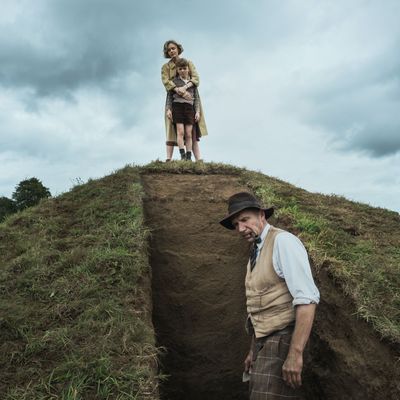
Horror films that involve people uncovering ancient burial grounds often suggest that the ghosts of the past are somehow coloring and clouding the present — that history never really goes away. Simon Stone’s The Dig, based on a novel by John Preston which itself was based on real events, is in no way a horror film, but it suggests pretty much the same thing, both narratively and stylistically. It’s a movie in which the newly unearthed past has a dramatic effect both on the characters’ lives and how they are presented onscreen.
The film opens with humble excavator and amateur archeologist Basil Brown (Ralph Fiennes) being called to the stately Suffolk home of wealthy widow Edith Pretty (Carey Mulligan). She wants him to dig up a series of large, mysterious mounds on her property, which have been the subject of speculation for decades. It’s the 1930s and war, it seems, is right around the corner. Fighters from a nearby airfield glide across the sky. Museums and excavations around the country scramble to finish their work and batten down the hatches for the oncoming devastation. Terse workingman Basil and the businesslike Edith come to an arrangement, and soon enough, he’s uncovering something far grander than anyone previously imagined — an entire ship buried underground, the tomb of an ancient Anglo-Saxon king and proof that the people who inhabited this land were more than mere Vikings. (The site in question, Sutton Hoo, proved to be one of the most consequential, not to mention lucrative, archeological finds in English history.)
The dig goes on, but so too does life. Basil and Edith are both buttoned-up in different ways. As their friendship develops, key parts of their lives go unspoken (buried, if you will); she doesn’t tell him, for example, that her weak heart means she may not have all that long to live, and that she worries about what will happen to her vivacious young son Robert. As the scale of the dig becomes apparent, the project grows and crews from the British Museum and from the local Ipswich Museum arrive, bringing with them their own emotional issues. Among the newcomers are Stuart and Peggy Piggott (Ben Chaplin and Lily James), an archeologist couple stuck in a passionless marriage. She has eyes for Rory Lomax (Johnny Flynn), Edith’s dashing, Royal Air Force–bound cousin. He has eyes for his colleague John Brailsford (Eamon Farren).
This all sounds rather melodramatic, but that is where the dig comes in. As our characters learn more about the past and the people who came before them, the small gestures of their own lives begin to feel both inconsequential and seismic. It’s an interesting philosophical question: Is the knowledge that we are mere blips in humanity’s existence (which is, in turn, a mere blip in the Earth’s) liberating or constraining? Is the discovery of this massive underground burial ship — itself a ghost, as the wood has long rotted away and merely left an elaborate imprint in compacted dirt (“There’s nothing holding it, except time”) — symbolic of human majesty, or human folly?
Stone, an acclaimed theater director, finds a moving cinematic correlative to these abstract ideas. He and screenwriter Moira Buffini (who also wrote 2013’s wonderful, underrated Neil Jordan vampire drama Byzantium) adopt an elliptical, glancing style that treats the present almost as if it were already a memory. Scenes weave in and out of each other, and are sometimes left unfinished. Conversations happen without anyone moving their mouths, the sounds of one intimate moment intruding on the images of another. (This is the Thin Red Line of archeology dramas.) Time jumps backward and forward. Death is intercut with passion, as tragedy and glory tangle onscreen. It’s as if the dig itself radiates out a new understanding of existence, revealing both the broad arc of history and the curlicues of love, loyalty, and loss that abound within it. That makes the film’s emotional perspective intriguing: This is a movie whose dramatic high point turns on the discovery of a “Merovingian tremissis” — a tiny gold coin — and what that says about the sixth century economy of East Anglia, and somehow, you find yourself choking back tears.
None of this would have worked without the presence of such fine actors. Particularly Fiennes and Mulligan, who, despite the fact that they are playing characters who are largely closed off to the world — these are not chatty, outward people — manage to convey entire galaxies of emotion in their scenes. There’s been some understandable griping about the age difference between them (the real Edith Pretty was apparently in her 50s when the events of the film took place, and the real Basil Brown a good deal younger) but their relationship, aside from a brief unspoken moment early in the film, isn’t a romantic one. (For what it’s worth, Mulligan is clearly playing older — she’s even been aged with some makeup — and was apparently a last-minute replacement for Nicole Kidman.) Besides, why complain about the actors when the acting is this glorious? Fiennes is always a wonder, but watching him here is a crash course in what a great performer can bring. His character grows somewhat less central as the narrative proceeds, but every time we see him, he gives us something new, a subtle gesture or glance that adds another layer to our understanding of him, and of the movie itself. Through such details, The Dig gathers a cumulative power that’s undeniable.
More Movie Reviews
- The Accountant 2 Can Not Be Taken Seriously
- Another Simple Favor Is So Fun, Until It Gets So Dumb
- Errol Morris Has Been Sucked Into the Gaping Maw of True Crime


